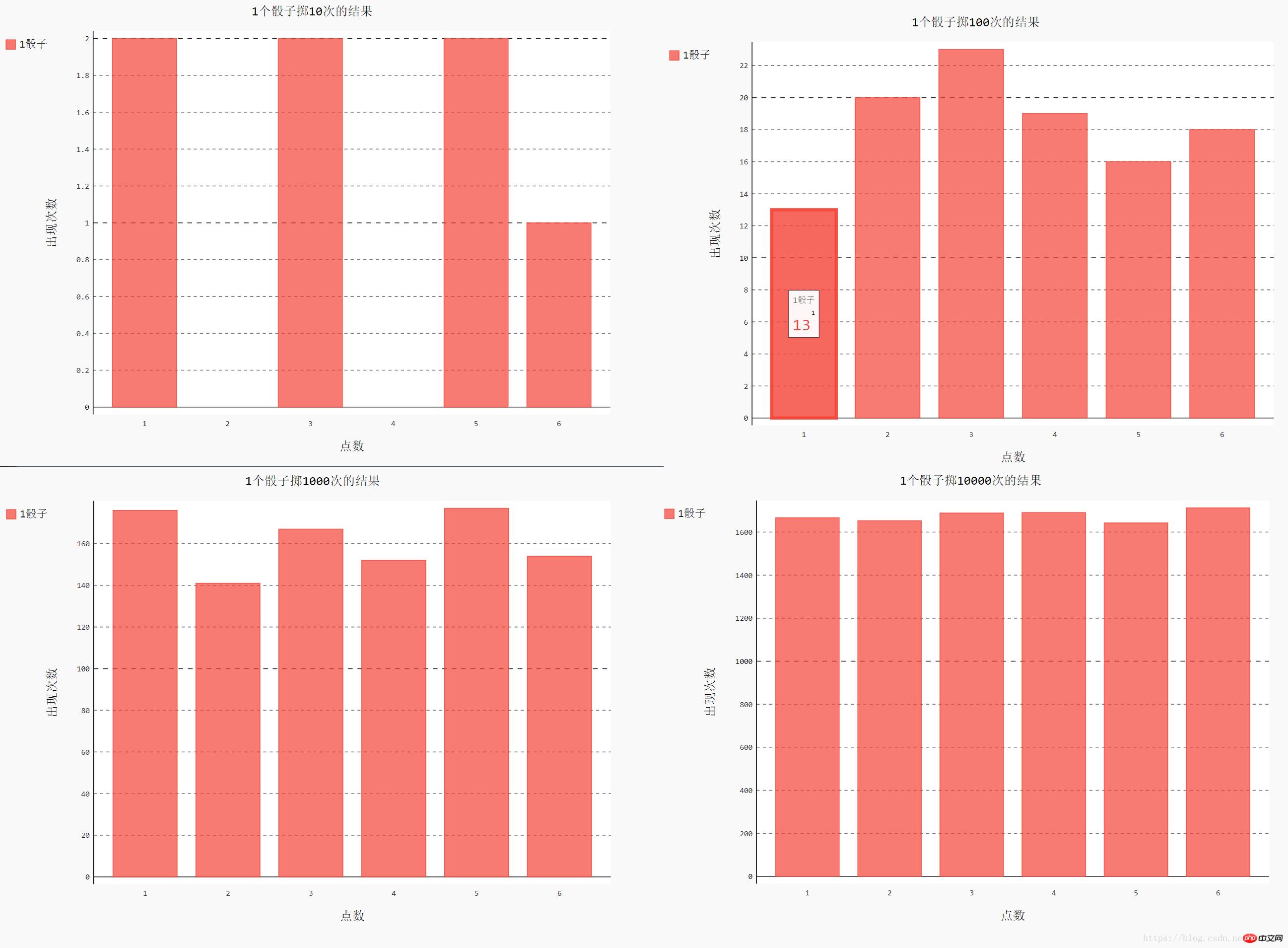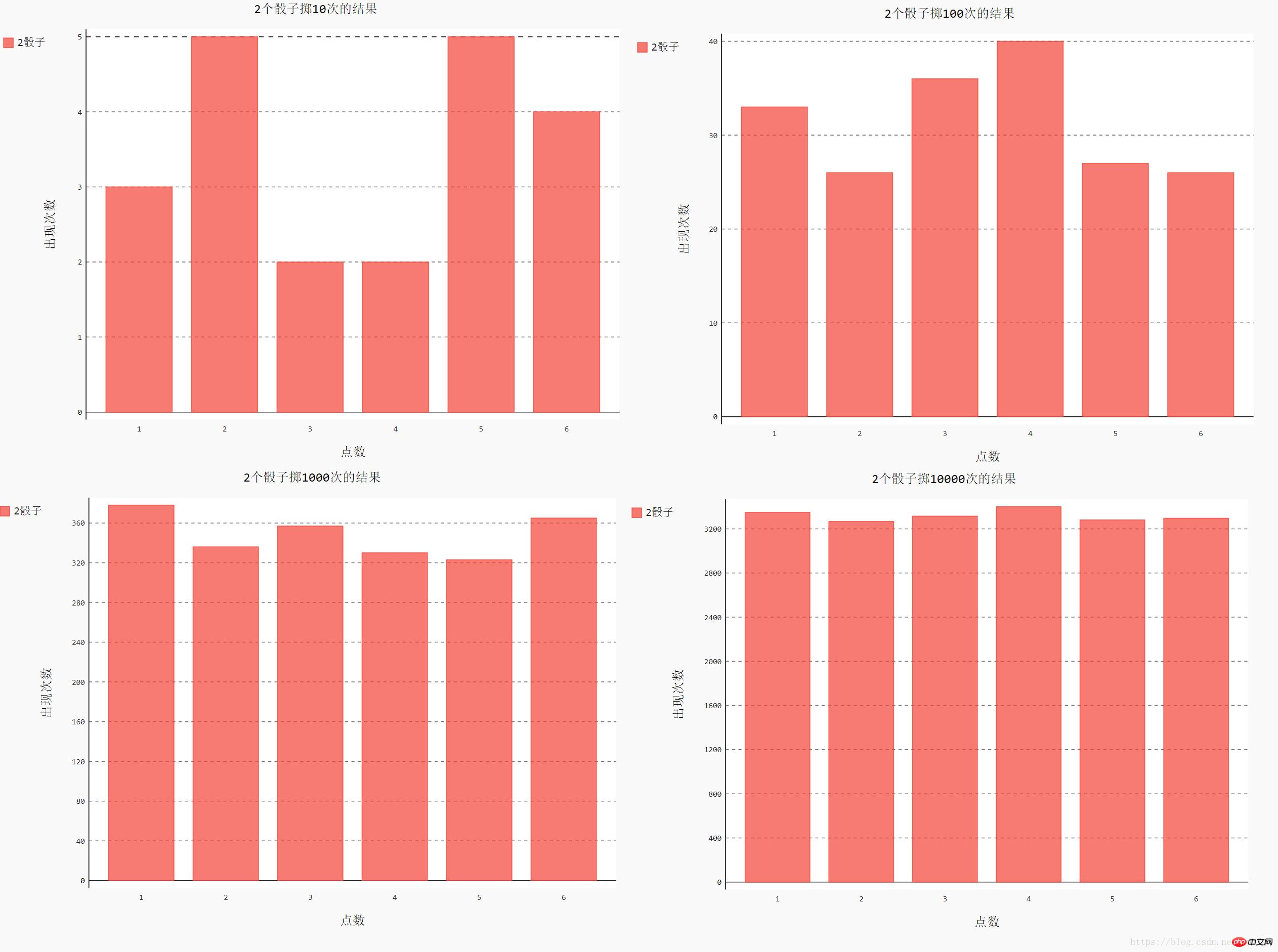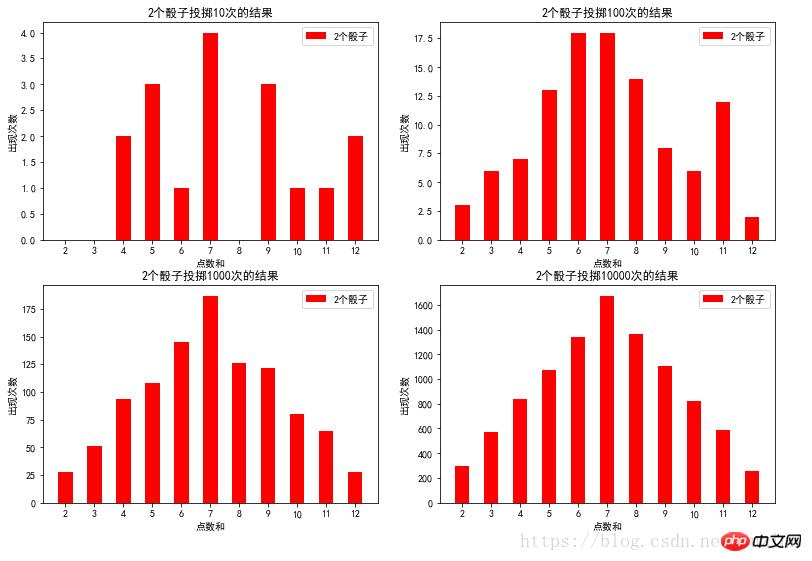python knowledge analysis dice game
The content shared with you in this article is about python knowledge analysis and dice throwing game. It has certain reference value. Friends in need can refer to it. I recently learned some statistics and python knowledge, and tried to analyze the dice game. The dice has a standard 6 sides, and the results of throwing 1, 2, 3, and 4 dice at a time, and throwing 10, 100, 1,000, and 10,000 times are analyzed.
use tools
Jupyter Notebook analysis tool
matplotlib, pygal visualization package
1, number of guesses
1-6中每个数字出现的次数
# 导入包 import pygal import numpy as np import matplotlib.pyplot as plt plt.rcParams['font.sans-serif']=['SimHei'] # 用来正常显示中文标签 plt.rcParams['axes.unicode_minus']=False # 用来正常显示负号 from random import randint
# 利用随机数据模拟掷骰子
# 每次显示1-6中的一个数
num_sides = 6 # 骰子的6个面
def getData(N, times):
"""
定义函数,获取投掷数据
N: 表示一次用几个骰子投
times:表示总共投几次
"""
results = []
for n in range(1,N+1):
for roll_num in range(times):
result = randint(1,num_sides)
results.append(result)
return results# 打印投掷结果 print(getData(1,10)) # 1个骰子掷10次 print(getData(2,5)) # 2个骰子掷5次
[2, 2, 2, 2, 1, 6, 4, 4, 5, 5] [4, 3, 5, 6, 2, 2, 3, 6, 4, 4]
# 分析结果# 统计每个数字出现的次数并显示图片
# N: 表示一次用几个骰子投
# data 表示投掷数据def showResult(N, times):
frequencies = [] for value in range(1, num_sides+1):
frequency = getData(N, times).count(value)
frequencies.append(frequency) # 数据可视化
# 本次利用 pygal 生成SVG格式矢量图
hist = pygal.Bar()
hist.title = str(N)+"个骰子掷"+ str(times) +"次的结果"
hist.x_labels = ['1','2','3','4','5','6']
hist.x_title = "点数"
hist.y_title = "出现次数"
hist.add(str(N)+'骰子', frequencies)
hist.render_to_file('1-'+str(N)+str(times)+'.svg') # 储存为矢量图# 一个骰子掷10,100, 1000, 10000次结果分析showResult(1,10) showResult(1,100) showResult(1,1000) showResult(1,10000)

# 2个骰子掷10,100, 1000, 10000次结果分析showResult(2,10) showResult(2,100) showResult(2,1000) showResult(2,10000)

3 dice , 4 dice will no longer take screenshots.
We found that the more times we throw, the closer the probability of each number appears, and finally tend to be the same.
2. Guess the size
每次投掷点数和
# 每次投掷点数和def getData2(N, times):
"""
定义函数,获取投掷数据
N: 表示一次用几个骰子投
times:表示总共投几次
"""
results = [] for roll_num in range(times):
result = 0
for n in range(1,N+1):
result += randint(1,num_sides)
results.append(result)
return results# 打印投掷结果print(getData2(1,10)) # 1个骰子掷10次print(getData2(2,5)) # 2个骰子掷5次
[4, 3, 6, 2, 5, 4, 5, 3, 6, 2] [6, 10, 5, 8, 7]
# 分析结果# 统计数字和出现的次数并显示图片
# N: 表示一次用几个骰子投
# data 表示投掷数据def showResult2(N, times):
frequencies = [] for value in range(N, N*num_sides+1):
frequency = getData2(N, times).count(value)
frequencies.append(frequency) # 数据可视化
# 本次利用 matplotlib 生成图片
x_num = N*num_sides+1-N
idx = np.arange(x_num)
width = 0.5
sn = str(N)
sm = str(times)
x_labels = [str(n) for n in range(N, N*num_sides+1)] # X轴刻度
plt.bar(idx, frequencies, width, color='red', label=sn+'个骰子')
plt.xlabel('点数和')
plt.ylabel('出现次数')
plt.title(sn+'个骰子投掷'+ sm +'次的结果')
plt.xticks(idx, x_labels)
plt.legend() # 显示图例
plt.show()It doesn’t make much sense to guess the size of one dice. Let’s directly analyze the situation of two dice.
# 2个骰子掷10,100, 1000, 10000次结果分析showResult2(2,10) showResult2(2,100) showResult2(2,1000) showResult2(2,10000)

# 3个骰子掷10,100, 1000, 10000次结果分析showResult2(3,10) showResult2(3,100) showResult2(3,1000) showResult2(3,10000)

# 4个骰子掷10,100, 1000, 10000次结果分析showResult2(4,10) showResult2(4,100) showResult2(4,1000) showResult2(4,10000)

We can see from the above pictures that when the number of throws is enough Often, the probability of large/small points appearing is basically the same, and the point size shows the characteristics of a normal distribution.
Related recommendations:
dice rolling game-C language implementation
practicing small Program: craps craps game
The above is the detailed content of python knowledge analysis dice game. For more information, please follow other related articles on the PHP Chinese website!

Hot AI Tools

Undresser.AI Undress
AI-powered app for creating realistic nude photos

AI Clothes Remover
Online AI tool for removing clothes from photos.

Undress AI Tool
Undress images for free

Clothoff.io
AI clothes remover

Video Face Swap
Swap faces in any video effortlessly with our completely free AI face swap tool!

Hot Article

Hot Tools

Notepad++7.3.1
Easy-to-use and free code editor

SublimeText3 Chinese version
Chinese version, very easy to use

Zend Studio 13.0.1
Powerful PHP integrated development environment

Dreamweaver CS6
Visual web development tools

SublimeText3 Mac version
God-level code editing software (SublimeText3)

Hot Topics
 1392
1392
 52
52
 PHP and Python: Different Paradigms Explained
Apr 18, 2025 am 12:26 AM
PHP and Python: Different Paradigms Explained
Apr 18, 2025 am 12:26 AM
PHP is mainly procedural programming, but also supports object-oriented programming (OOP); Python supports a variety of paradigms, including OOP, functional and procedural programming. PHP is suitable for web development, and Python is suitable for a variety of applications such as data analysis and machine learning.
 Choosing Between PHP and Python: A Guide
Apr 18, 2025 am 12:24 AM
Choosing Between PHP and Python: A Guide
Apr 18, 2025 am 12:24 AM
PHP is suitable for web development and rapid prototyping, and Python is suitable for data science and machine learning. 1.PHP is used for dynamic web development, with simple syntax and suitable for rapid development. 2. Python has concise syntax, is suitable for multiple fields, and has a strong library ecosystem.
 Can vs code run in Windows 8
Apr 15, 2025 pm 07:24 PM
Can vs code run in Windows 8
Apr 15, 2025 pm 07:24 PM
VS Code can run on Windows 8, but the experience may not be great. First make sure the system has been updated to the latest patch, then download the VS Code installation package that matches the system architecture and install it as prompted. After installation, be aware that some extensions may be incompatible with Windows 8 and need to look for alternative extensions or use newer Windows systems in a virtual machine. Install the necessary extensions to check whether they work properly. Although VS Code is feasible on Windows 8, it is recommended to upgrade to a newer Windows system for a better development experience and security.
 Is the vscode extension malicious?
Apr 15, 2025 pm 07:57 PM
Is the vscode extension malicious?
Apr 15, 2025 pm 07:57 PM
VS Code extensions pose malicious risks, such as hiding malicious code, exploiting vulnerabilities, and masturbating as legitimate extensions. Methods to identify malicious extensions include: checking publishers, reading comments, checking code, and installing with caution. Security measures also include: security awareness, good habits, regular updates and antivirus software.
 Can visual studio code be used in python
Apr 15, 2025 pm 08:18 PM
Can visual studio code be used in python
Apr 15, 2025 pm 08:18 PM
VS Code can be used to write Python and provides many features that make it an ideal tool for developing Python applications. It allows users to: install Python extensions to get functions such as code completion, syntax highlighting, and debugging. Use the debugger to track code step by step, find and fix errors. Integrate Git for version control. Use code formatting tools to maintain code consistency. Use the Linting tool to spot potential problems ahead of time.
 How to run programs in terminal vscode
Apr 15, 2025 pm 06:42 PM
How to run programs in terminal vscode
Apr 15, 2025 pm 06:42 PM
In VS Code, you can run the program in the terminal through the following steps: Prepare the code and open the integrated terminal to ensure that the code directory is consistent with the terminal working directory. Select the run command according to the programming language (such as Python's python your_file_name.py) to check whether it runs successfully and resolve errors. Use the debugger to improve debugging efficiency.
 Can vscode be used for mac
Apr 15, 2025 pm 07:36 PM
Can vscode be used for mac
Apr 15, 2025 pm 07:36 PM
VS Code is available on Mac. It has powerful extensions, Git integration, terminal and debugger, and also offers a wealth of setup options. However, for particularly large projects or highly professional development, VS Code may have performance or functional limitations.
 Python vs. JavaScript: The Learning Curve and Ease of Use
Apr 16, 2025 am 12:12 AM
Python vs. JavaScript: The Learning Curve and Ease of Use
Apr 16, 2025 am 12:12 AM
Python is more suitable for beginners, with a smooth learning curve and concise syntax; JavaScript is suitable for front-end development, with a steep learning curve and flexible syntax. 1. Python syntax is intuitive and suitable for data science and back-end development. 2. JavaScript is flexible and widely used in front-end and server-side programming.




